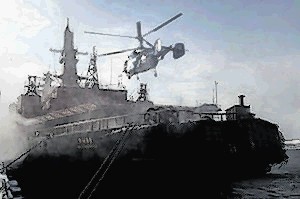
Norway is not the only oil and gas producer that must raise its environmental game in the High Arctic; Russia must too.
This is why the Kara-Winter-2014 Expedition organised by the Arctic Research and Design Center (a joint venture of Rosneft and ExxonMobil) with expert support from the Arctic and Antarctic Research Institute has just got under way.
According to Rosneft, this is going to be the largest ice expedition conducted by Russia since the USSR collapsed. The team aboard the icebreaker Yamal will study ice conditions of three seas: the Laptev, Kara, and East-Siberian Seas.
The expedition route runs along some of the least explored sea areas of the Arctic Ocean.
The joint team will be examining late winter ice to determine the ice phases, the morphometric parameters of the ice cover, physical and chemical properties of the ice, ice ridges and stamukhas as well as weather and water mass conditions.
For the first time iceberg drift will be studied by attaching buoys to a selected number and engineering surveys will be conducted for the East Siberia and Laptev Seas.
Aside from the Yamal, which is a nuclear ice-breaker, the expedition will use satellites, a helicopter, an unmanned air drone, an underwater camera, buoys and an array of research instruments.
Data obtained by the expedition will be interpreted and 3D models of ice formations will be built to support exploration and subsequent oil and gas field facility design activities.
The expedition will also focus on biological studies and environmental protection measures. Marine mammal and bird observations will be conducted throughout the expedition, including on board the drone and helicopter.
The data obtained will be used to develop “environmentally friendly” Arctic oil and gas exploration and production technologies, according to Rosneft, which currently holds 46 exploration licences for offshore Russia.
The company has already conducted a number of research expeditions in its offshore Arctic licence areas.
In August 2013 alone, those involved 13 various class vessels, three aircraft, a number of unmanned drones, subsea and above-water recording stations, satellite observation systems and ROVs.
Various other Russian and international research and design organisations participated in the studies.